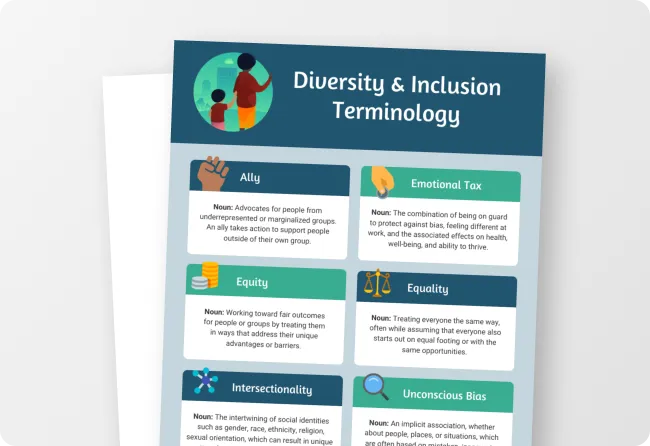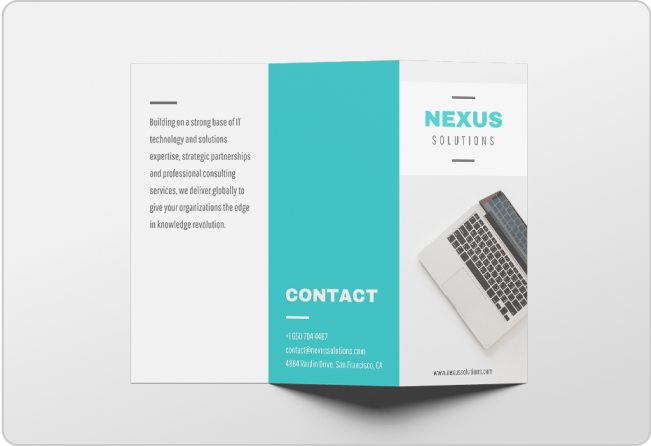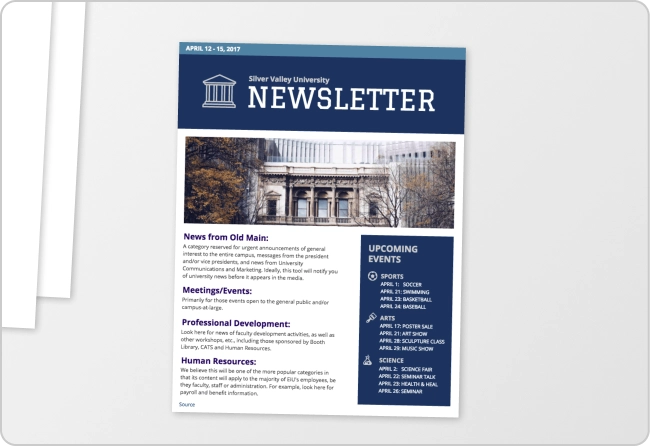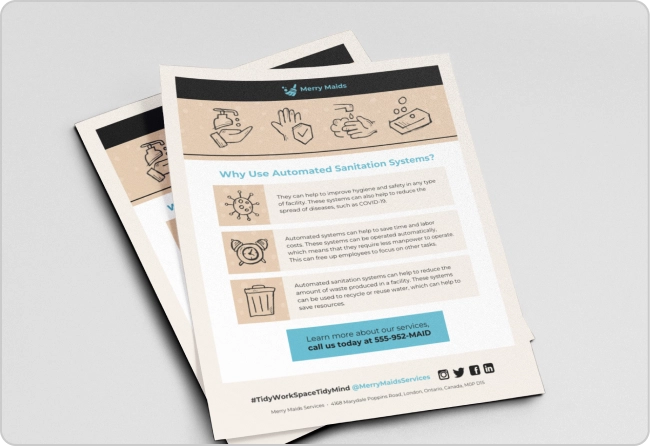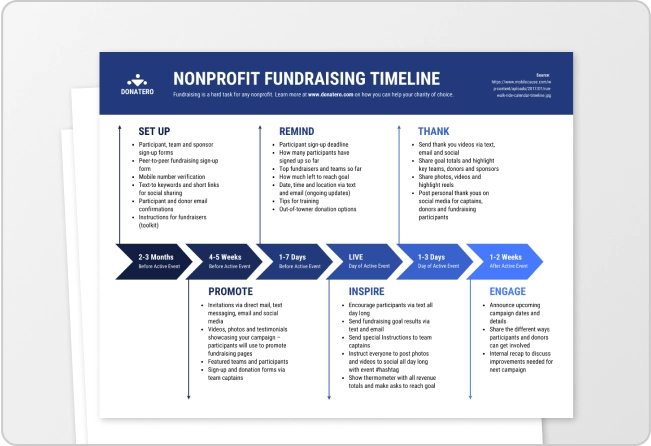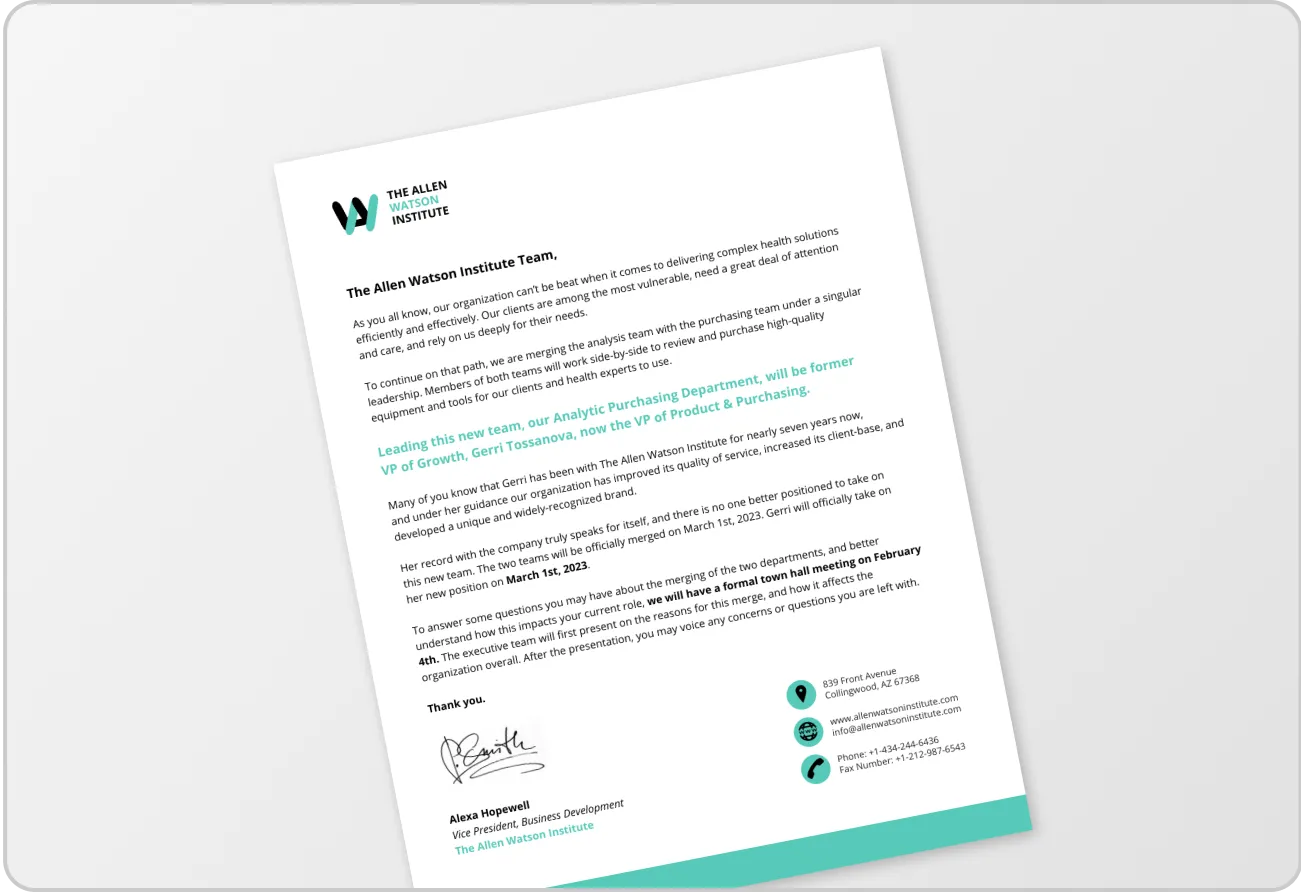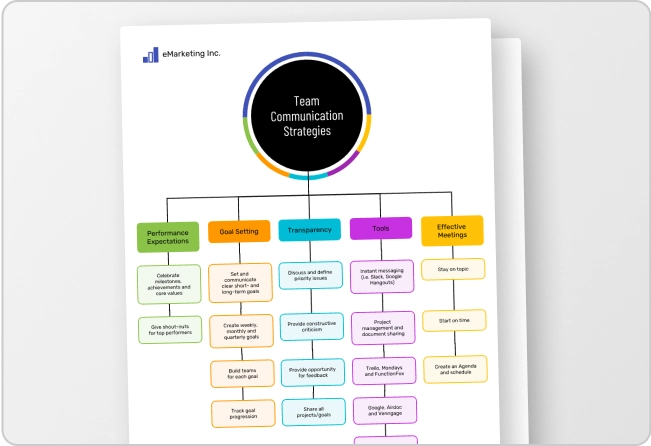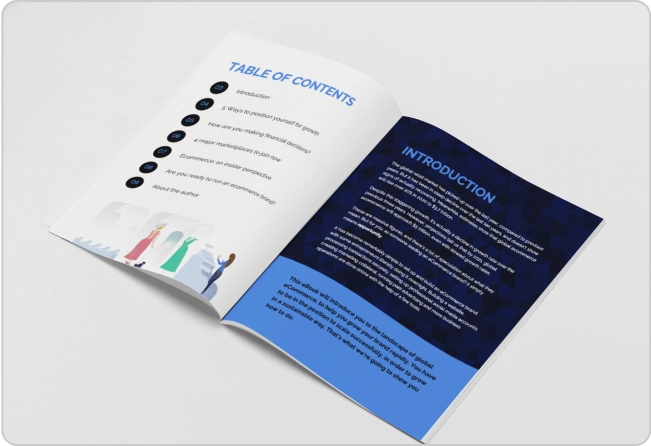
Starting a new job can feel overwhelming, for both the new hire and the HR team. In fact, 81% of new hires report feeling overwhelmed with information during the onboarding process. Between paperwork, training and introductions, it’s easy to miss important details. That’s where an onboarding checklist helps keep everything organized.
This guide explains how to create a clear onboarding checklist that supports new hires from day one. With Venngage’s checklist maker, you can easily customize and share your own checklist with no design experience needed.
I truly believe that onboarding is an art. Each new employee brings with them a potential to achieve and succeed. To lose the energy of a new hire through poor onboarding is an opportunity lost.
Sarah Wetzel, Director of Human Resources at engage:BDR
What is onboarding and why it matters?
Onboarding is the process of hiring and integrating new employees into your organization. Organizations with a strong onboarding process improve new hire retention by 82% and productivity by over 70%. Yes, it includes things like having their picture taken for a name tag, and setting them up on your employee management app, but it also extends to making them feel comfortable in their jobs and welcomed into your organization’s culture.
As Laszlo Bock, former Senior Vice President of People Operations at Google, put it: “At Google, we front-load our people investment. This means the majority of our time and money spent on people is invested in attracting, assessing, and cultivating new hires.”
That philosophy highlights the importance of investing early in employees through a thoughtful onboarding experience.
What is an onboarding checklist?
An onboarding checklist is an organizing document that serves a dual purpose. First a new hire process templates guides employees through their first days, weeks and months of employment. It does so by informing them on the steps they’ll need to complete during training, so they know what’s expected of them.
Second, these checklists help employers remember the steps they need to take to set up new hires for success in their role. Its completion verifies to leaders that they’ve prepared employees effectively to succeed at their day-to-day tasks, and understand what’s expected of them.
Check out the infographic below for a quick summary of the four phases. You can also find more information in the FAQ.

Related: 11+ Tips for the Best Employee Onboarding Process
Pre-onboarding checklist: setting new hires up for day one
Onboarding doesn’t start on an employee’s first day, it begins the moment they accept the offer. A pre-onboarding checklist ensures everything is ready so your new hire feels welcomed, informed and equipped from the start.
Companies that implement pre-boarding procedures aimed at fostering communication and generating excitement among new hires can decrease turnover by 20% during the initial 45 days of employment.
Here are key tasks to complete before Day 1:
- Confirm the hire and finalize the start date in your HR system.
- Complete background checks and employment verification to avoid delays.
- Send a welcome email outlining what to expect on their first day.
- Notify the team and assign a mentor or onboarding buddy.
- Prepare new hire paperwork, including contracts, tax forms and direct deposit forms.
- Set up computer equipment and necessary software access.
- Arrange workstation or remote setup, ensuring access to tools and credentials.
Including these steps in your onboarding process builds trust, reduces confusion and helps new employees hit the ground running.
As James Dimon, Chairman and CEO of JPMorgan Chase, explains:
“We reinforce our culture every chance we get. Our Business Principles are at the forefront of everything we do, and we need to make these principles part of every major conversation at the company—from the hiring, onboarding, and training of new recruits to town halls and management meetings to how we reward and incentivize our people.”
This perspective underscores how effective onboarding goes beyond logistics, it’s also an opportunity to introduce new hires to your company’s values and culture from day one.
What should an onboarding document include?
An onboarding document typically consists of several checklists to cover different activities effectively. For example, a compliance checklist is more straightforward compared to one focusing on organizational culture. Consider the four phases of onboarding when designing your materials:
Key elements of an onboarding document:
Compliance (first week):
- Complete paperwork and provide legally required documents.
- Review the employee handbook.
- Receive ID, business cards, and access keys/keycards.
- Learn to use office equipment, including computers and phones.
- Get a tour of the facilities.
- Meet teammates and key personnel.
Clarification (first month):
- Receive training on daily job tasks.
- Go through job aid.
- Shadow colleagues who excel at specific responsibilities.
- Conduct regular check-ins with supervisors for feedback and guidance.
Culture (first six months):
- Understand company norms and unwritten rules.
- Seek clarification on policies, tasks, or procedures as needed.
- Build relationships within the organization.
- Take on more responsibilities as appropriate.
- Participate in a six-month performance review.
Connection (first year):
- Engage in an annual performance review.
- Strengthen relationships with colleagues.
- Master job tasks and functions.
“We want to focus on creating a memorable experience for the new hire in the first year rather than processing them in the first few weeks.”
Cheryl Hughey, Director of Onboarding at Southwest Airlines
Certain aspects, like compliance tasks, are well-suited for checklist formats, while cultural and connection-building elements may require a more informal approach. Tailor your onboarding documents to reflect these nuances.
14+ onboarding checklist templates
Employee onboarding checklists
The checklists can cover a variety of topics, and they can also help you keep track of the onboarding process itself. Your employee orientation guide may consist of several pages, or it may be short and sweet.

Customize checklist to cover a variety of facets of training a new team member, from making sure their paperwork is on file to ensuring they’re thriving in their new role.
Below is another great option. This employee orientation guide has space to assign team members to each task.

Make sure everybody on the team knows what areas they’ll be responsible for when it comes to training a new hire. Assign different duties to those best suited for them, and hold them responsible for the new team member’s uptake of that information.
New employee training checklists
This training checklist offers a modern and sleek alternative to the above onboarding templates.
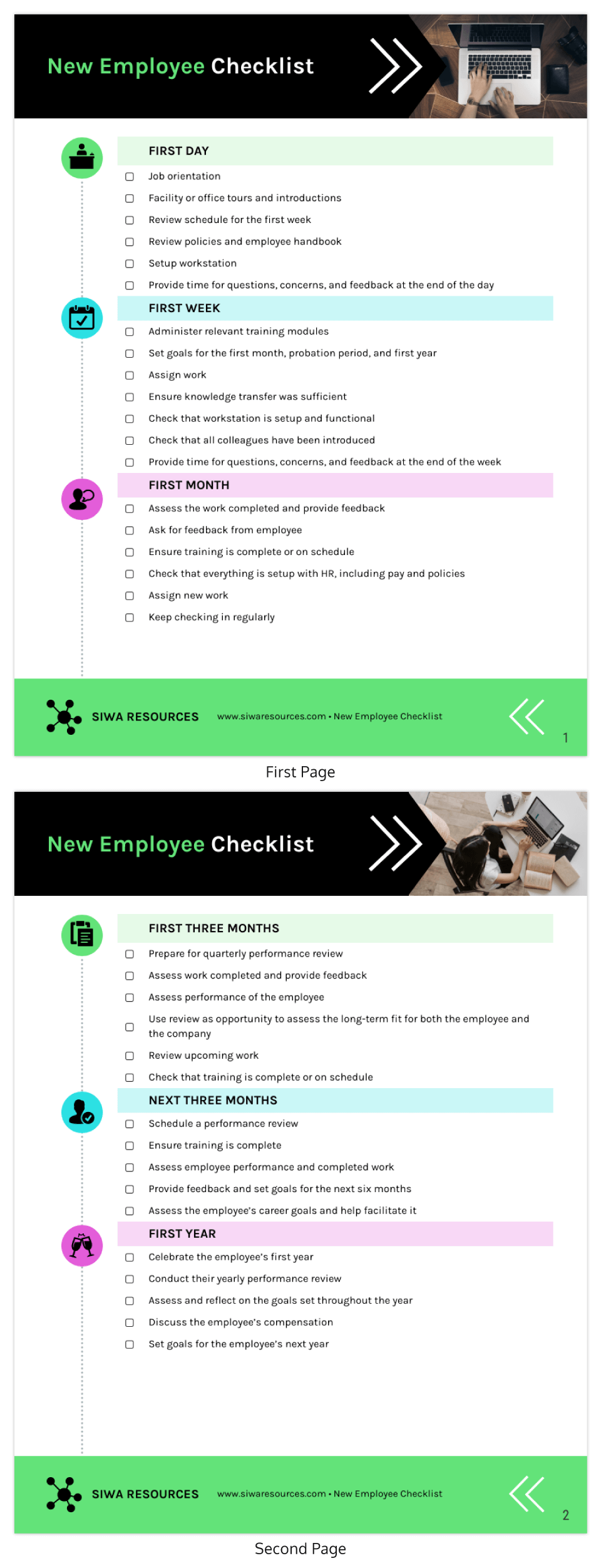
This template offers a high-level summary of what to expect, spanning from the first day of employment to the first year. It’s also one of my favourites, because the checklist shows you have a long-term vision for their success.
For a more casual and relaxed feel, try the template below.
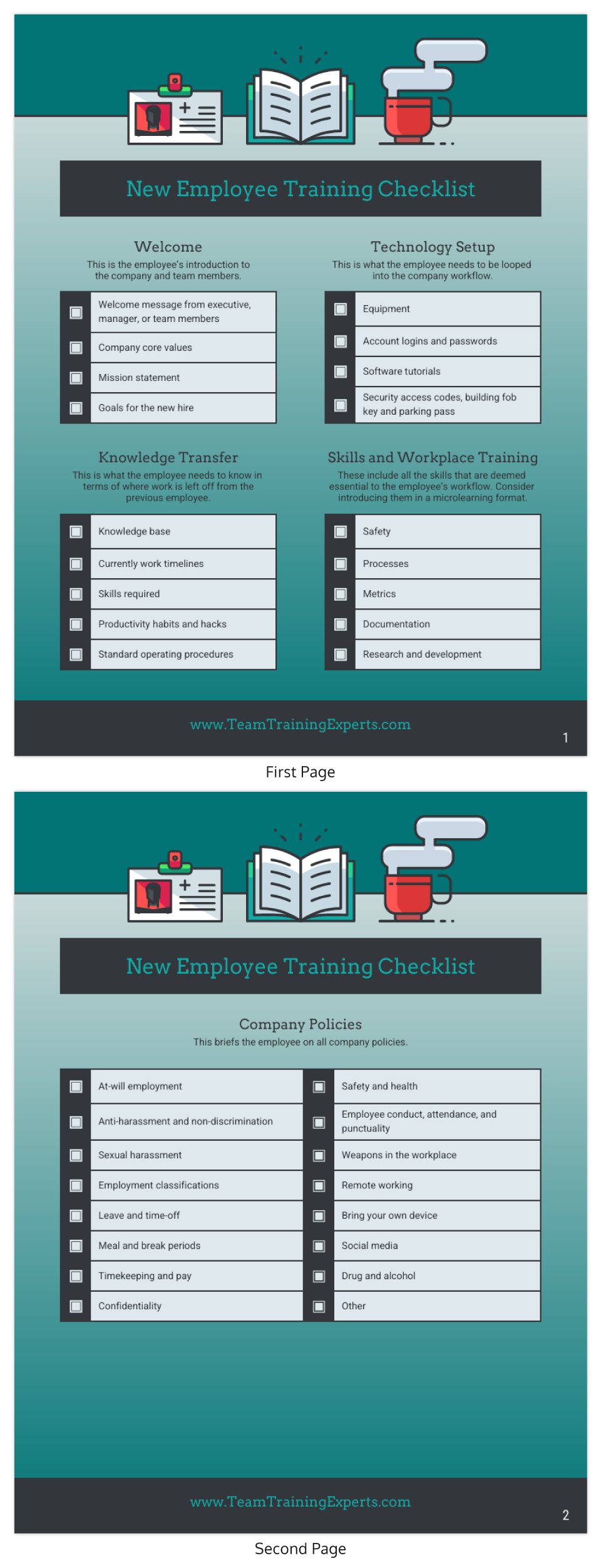
This one spans a variety of onboarding initiatives and areas to review, broken down into sections. Placing specific emphasis on company policies lends well to organizations who have a number of conduct rules to abide by.

Though this checklist is technically an offboarding checklist, it could easily be modified to cover training employees on all the equipment they’ll need to do their jobs. (Learn more about how to create an effective offboarding process.)

And this template was designed to ensure enhanced cleaning guidelines are followed, but your organization could customize it to cover the policies you’ve gone over with a new employee during their first few days on the job.
New hire onboarding checklist
New hire checklists are best used during the first few days with a new employee. Use them to make sure important legal documents have been filed and a variety of company policies have been explained.

This new hire checklist is ideal to have on hand for employees in just about any department. Update and expand the first section to cover the documentation your company has to collect for legal and compliance purposes.
IT onboarding checklist template
An IT onboarding checklist is a structured guide that outlines the key steps and tasks needed to seamlessly integrate a new hire into an organization’s IT systems and processes. It plays a crucial role during the onboarding process, especially for remote developers, ensuring they quickly adapt to tools, workflows, and security protocols for maximum productivity.
Below is an example of an IT offboarding checklist, which outlines steps to securely terminate an employee’s access to IT systems and assets during their departure or when access privileges need to be revoked.
This template is versatile and can easily be adapted into an onboarding checklist to suit your organization’s needs.

HR onboarding checklist

Remote employee onboarding checklist
This remote onboarding checklist is designed to support new hires working from anywhere, ensuring they feel connected and prepared despite the distance. It provides a clear, step-by-step guide to their virtual tasks, introduces them to the company’s culture and tools, and helps them integrate seamlessly into their role, no matter their location.
For companies looking to streamline remote onboarding with the help of intelligent tools, Borderless AI offers innovative solutions to simplify global hiring and onboarding at scale.
Onboarding checklist templates
Onboarding checklists can help you keep track of the entire onboarding process from start to finish, or they can touch on one or two aspects of the overall process.

Send this to a new hire before their first day begins so that they arrive on Day One ready to get started.

Adding gamified elements to your checklist all but guarantees employee engagement. While this template is geared towards employee development, it’s a cinch to rework the content so it reflect stages of the onboarding process instead. New hires will be more motivated than ever to “level up” their training.
Related: 12+ Employee Development Plan Examples for Businesses

This checklist template is ideal for ensuring both supervisor and employee agree that each task has been done. If the supervisor has checked something off but the employee hasn’t, that’s a good sign that your onboarding process needs a bit of work.

Though this is an audit checklist, it’s organized in a way that’s ideal for monitoring employee onboarding thanks to the color-coded sections.
General onboarding templates
A good onboarding template can include checklists, but there are other types of materials that are useful for both the organization and the employee during the onboarding process. This includes manuals, presentations and more.

This remote employee onboarding template is ideal for the tricky task of bringing new remote workers onto your team. Even after the pandemic, many companies are expected to accelerate their use of remote work, and onboarding is a major challenge when employees and managers are in different physical locations.

As this microlearning onboarding menu shows, creating engaging materials can be a useful way to make sure both the employee and their supervisors and team members don’t lose steam.

Present your orientation manual in an easy-to-understand format like this template. Update icons as needed and use your brand’s colors to reinforce your company identity.
Related: 20+ Training Plan Templates for Every Business Need
Onboarding process templates
Creating an onboarding process is challenging, but Venngage has you covered there, too. Take a look at some simple onboarding process templates and guides to help you craft your own onboarding materials.

Use the advice in this infographic to help craft your onboarding strategy, and remember that what works for other companies may not work for yours. If certain processes aren’t effective, refine or abandon them.

When setting out to craft your orientation processes and procedures, consider what exactly you want to get out of them. Then, create materials that speak to those objectives. Need help with documenting business processes? We’ve got you covered.

A good new-hire process begins long before you even have a job opening, as understanding what it takes to be successful in your organization begins with the job functions themselves. This infographic can help you explore in more depth how to welcome new employees and transform them into successful team members.
Employee onboarding handbook
Time to bring it all back to where we started! Don’t forget to review and update other forms of employee onboarding documents you’ll share, including your employee handbooks.

Here’s one I really enjoy. Its playful color pallette and diverse icons bring a welcoming feel to documents that are often boring and drab.
And if that’s not your speed, there are a ton of other employee handbook templates to choose from.
How to design onboarding checklist with Venngage?
Creating an onboarding checklist can be as simple as putting pen to paper. If you want to repeat a good onboarding process over and over again, creating engaging materials with Venngage is a good option.
Here are 5 simple steps to help you create an actionable and clear checklist for effective onboarding processes:
- Step 1: Think back to the four Cs and determine what phase or phases the checklist should cover.
- Step 2: Pick the onboarding checklist template that best suits your needs (scroll down to see our collection of onboarding templates)
- Step 3: Update the steps to cover your specific needs.
- Step 4: Apply your company’s brand guidelines with a few clicks using My Brand Kit.
- Step 5: Download and print the checklist to share it with your new hire.
If you’re a Venngage Business user, you can apply brand colors, font and logo to your design in just one click:

And you can also collaborate with your team members in real time, which really comes in handy when you need to create collaborative materials like onboarding checklists:

Now, let’s take a look at some of the templates you can customize for your new hire orientation and onboarding.
Common Onboarding Challenges and How to Overcome Them
Even the best onboarding plans can hit a few bumps. For HRs and hiring managers, recognizing these challenges early helps you create a smoother experience for new hires and avoid common pitfalls.
1. Information overload
New hires often receive too much information at once. Space out training sessions and use an onboarding checklist to organize tasks into manageable steps.
2. Lack of role clarity
Unclear responsibilities can lead to confusion. Ensure managers review specific goals and expectations within the first week and document them in your onboarding materials.
3. Limited engagement
Without early engagement, new hires may feel disconnected. Encourage team introductions, mentorship programs and regular check-ins to build connection and confidence.
4. Inconsistent processes
Different departments may follow different onboarding steps. Standardize procedures using Venngage’s checklist maker so every employee gets the same level of support.
5. Overlooking feedback
Skipping feedback can make it harder to improve onboarding. Collect input from new hires after their first month to refine your checklist and ensure continuous improvement.
Onboarding checklist template FAQ
What are the four phases of onboarding with examples?
The four phases on onboarding are:
- Compliance: New hires complete paperwork, review manuals, and learn processes like requesting time off or insurance coverage details.
- Clarification: Ensures employees understand their job responsibilities, daily tasks, and how their role fits within the organization.
- Culture: Familiarizes new hires with company norms, values, and unwritten practices beyond policies.
- Connection: Helps build relationships with teammates and fosters a sense of belonging through introductions and team interactions.
Related: How to Create an Engaging Orientation & Onboarding Program for New Employees
How do I edit onboarding checklist templates in Venngage?
You can edit your onboarding checklist templates in four steps:
- Sign up for a free Venngage account
- Select the onboarding checklist template that best suits your needs
- Customize the templates’ text and visual assets so they speak to your organization
- Optional: apply your company’s brand guidelines with a few clicks using Venngage’s My Brand Kit
- Share or download as desired
Note: sharing is available free-of-charge. However, the option to download your creations and access features like My Brand Kit and Team Collaboration are available with a Business plan.
Check out this section for more information.
How do you measure onboarding process effectiveness?
Employee feedback is a great way to review the results of your onboarding process and programs. HR managers and team leaders can accomplish this through scheduling 1:1s with the employee. There, they can share their onboarding experience and any questions or concerns they have.
For quantitive info, employee feedback surveys are also a great option. Use these to garner quick feedback or to reference when reporting.
Did you know?
Employees with a clear understanding of their roles are more likely to stay engaged!
Onboard new team members like a pro with a handy onboarding checklist
With these handy onboarding templates, you’ll be ready to onboard any new hire like a pro. Use Venngage for HR professionals to create onboarding checklists, manuals, presentations and other materials to share with new hires.
Browse through our extensive collection of professional templates designed to upgrade the employee communication process, and easily apply your brand guidelines and collaborate in real-time with team members while designing your HR materials. It’s free to get started.






























